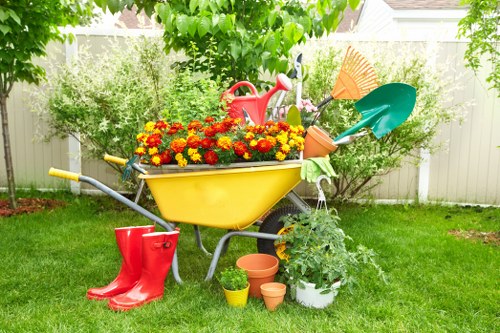Comprehensive Guide to Kitchen Cleaning

Maintaining a clean kitchen is essential for both the aesthetic appeal of your home and the health of your household. A spotless kitchen not only provides a pleasant environment but also ensures that your food is prepared in a hygienic space, free from contaminants and bacteria.
Effective home cleaning in kitchen cleaning involves a systematic approach, addressing every corner and surface to achieve a truly clean and organized space. Whether you’re preparing for a special occasion or simply aiming to maintain daily cleanliness, understanding the best practices can make the process more efficient and less daunting.
In this article, we will delve into various aspects of kitchen cleaning, offering tips, techniques, and strategies to help you keep your kitchen sparkling clean.
Essential Kitchen Cleaning Tools

Having the right tools at your disposal is crucial for effective kitchen cleaning. Equip yourself with these essential items to ensure thorough and efficient cleaning:
- Microfiber Cloths: Perfect for dusting and wiping surfaces without leaving streaks.
- Scrubbing Brushes: Ideal for tackling tough stains and grime on various surfaces.
- All-Purpose Cleaners: Versatile cleaners that can be used on most kitchen surfaces.
- Dishwasher Detergent: Essential for maintaining a clean and odor-free dishwasher.
- Gloves: Protect your hands from harsh chemicals and hot water.
Investing in high-quality cleaning tools can significantly enhance your kitchen cleaning routine, making the process faster and more effective.
Additionally, consider eco-friendly cleaning products to minimize your environmental footprint while keeping your kitchen spotless.
Daily Kitchen Cleaning Routine

Establishing a daily cleaning routine can prevent the accumulation of dirt and grime, making deep cleaning sessions less intensive. Here’s a simple daily cleaning checklist:
- Wipe Down Surfaces: Clean countertops, stovetops, and table surfaces after each meal.
- Wash Dishes: Ensure dishes are washed promptly to avoid buildup in the sink.
- Sweep Floors: Remove crumbs and debris from the kitchen floor daily.
- Take Out Trash: Prevent odors by emptying the trash regularly.
- Clean Spills Immediately: Address any spills or stains as soon as they occur to prevent staining and attract pests.
Maintaining a consistent daily routine helps keep your kitchen clean and reduces the need for extensive cleaning sessions.
Incorporate these habits into your daily life to ensure a perpetually clean and inviting kitchen.
Deep Cleaning Your Kitchen

While daily maintenance is important, deep cleaning your kitchen periodically ensures a thorough cleanse, reaching areas that are often neglected.
Here are steps to deep clean your kitchen effectively:
- Clean Appliances: Remove and clean stovetop burners, oven racks, and microwave interiors.
- Sanitize Cabinets and Drawers: Wipe down the interiors and exteriors to remove grease and grime.
- Deep Clean the Sink: Use baking soda and vinegar to eliminate stains and odors.
- Scrub the Floors: Mop the floors with appropriate cleaners to remove stubborn stains and dirt.
- Clean Behind Appliances: Move heavy appliances to clean the hidden areas behind them.
Deep cleaning not only enhances the appearance of your kitchen but also prolongs the lifespan of your appliances and surfaces.
Schedule deep cleaning sessions at least once a month to maintain a hygienic and organized kitchen environment.
Eco-Friendly Kitchen Cleaning Tips

Adopting eco-friendly cleaning practices benefits both your health and the environment. Here are some sustainable kitchen cleaning tips:
- Use Natural Cleaners: Utilize ingredients like vinegar, baking soda, and lemon for effective and non-toxic cleaning solutions.
- Reduce Plastic Use: Opt for reusable cleaning cloths instead of disposable wipes.
- Recycle: Properly dispose of or recycle packaging from cleaning products.
- Conserve Water: Use water-efficient cleaning methods to minimize water waste.
- Choose Biodegradable Products: Select cleaning products that break down naturally without harming the environment.
Implementing these eco-friendly practices contributes to a sustainable household while keeping your kitchen clean.
Making small changes in your cleaning routine can lead to significant environmental benefits over time.
Kitchen Organization for Easier Cleaning

An organized kitchen simplifies the cleaning process, making it easier to maintain a tidy space. Here are some organizational tips:
- Declutter: Remove unnecessary items from countertops and cabinets to reduce surfaces that need cleaning.
- Use Storage Solutions: Implement shelves, racks, and containers to keep items neatly arranged.
- Label Containers: Clearly label storage containers to quickly locate items and maintain order.
- Maintain Clear Pathways: Ensure there is enough space to move around the kitchen without obstruction.
- Regularly Assess Inventory: Periodically check and reorganize kitchen items to prevent clutter from accumulating.
Effective organization not only enhances the appearance of your kitchen but also reduces the effort required for cleaning.
Adopting these strategies can transform your kitchen into a more functional and easily maintainable space.
Maintaining Kitchen Hygiene
Kitchen hygiene is paramount to prevent foodborne illnesses and ensure a safe cooking environment. Follow these hygiene tips:
- Wash Hands Regularly: Always wash your hands before and after handling food.
- Separate Raw and Cooked Foods: Avoid cross-contamination by keeping raw meats separate from other foods.
- Store Food Properly: Use airtight containers for perishables to keep them fresh and safe.
- Regularly Clean Cutting Boards: Disinfect cutting boards to eliminate bacteria buildup.
- Monitor Expiry Dates: Keep track of food expiration dates to prevent using spoiled ingredients.
Implementing these hygiene practices ensures that your kitchen remains a safe space for meal preparation.
Consistent attention to cleanliness can significantly reduce the risk of contamination and health issues.
Dealing with Common Kitchen Messes
Every kitchen faces its share of messes, from grease spills to stubborn stains. Here’s how to handle common kitchen cleaning challenges:
- Grease Buildup: Use degreasers or a mixture of vinegar and water to break down and remove grease from surfaces.
- Stubborn Stains: Apply baking soda and water paste to stained areas, let it sit, and then scrub gently.
- Mold and Mildew: Use a bleach solution or hydrogen peroxide to eliminate mold in damp areas like sinks and countertops.
- Sticky Residues: Utilize rubbing alcohol or vinegar to dissolve sticky substances from surfaces.
- Odors: Place baking soda in refrigerators and pantries to absorb unwanted smells.
Addressing these common issues promptly can prevent them from escalating and maintain the overall cleanliness of your kitchen.
Regular maintenance and timely intervention are key to keeping your kitchen free from persistent messes.
Choosing the Right Cleaning Products
Selecting appropriate cleaning products is crucial for effective kitchen cleaning. Consider the following when choosing products:
- Surface Compatibility: Ensure the product is suitable for the specific kitchen surface you intend to clean.
- Non-Toxic Ingredients: Opt for products that are safe for your family and pets.
- Effectiveness: Choose cleaners that effectively remove the type of dirt or stain you are dealing with.
- Eco-Friendly Options: Prefer biodegradable and environmentally friendly products when possible.
- Ease of Use: Select products that are easy to apply and require minimal effort for maximum results.
Using the right cleaning products enhances the efficiency of your cleaning routine and ensures the longevity of your kitchen surfaces.
Always read labels and instructions to ensure safe and effective use of cleaning agents.
Preventative Measures for a Clean Kitchen
Taking preventative measures can significantly reduce the amount of cleaning required and keep your kitchen perpetually clean.
- Use Mats and Trivets: Protect countertops and stovetops from spills and heat damage by using mats and trivets.
- Dispose of Waste Promptly: Keep garbage containers sealed and empty them regularly to prevent spills and odors.
- Cover Food Items: Prevent spills and contamination by covering food items when not in use.
- Organize Cleaning Supplies: Keep cleaning materials readily accessible to address messes immediately.
- Avoid Eating in the Kitchen: Limit eating in the kitchen area to reduce crumbs and spills on surfaces.
Implementing these preventative strategies minimizes the effort required for maintaining a clean kitchen.
Prevention is always better than cure, especially when it comes to keeping your kitchen spotless.
Professional Kitchen Cleaning Services
If maintaining a clean kitchen becomes overwhelming, consider hiring professional kitchen cleaning services. These experts offer comprehensive cleaning solutions tailored to your needs.
- Thorough Cleaning: Professionals ensure every nook and cranny is cleaned to perfection.
- Time-Efficient: Save time by outsourcing cleaning tasks to experts.
- Expertise: Benefit from the knowledge and experience of trained cleaning personnel.
- Customized Services: Choose services that align with your specific cleaning requirements.
- Health Benefits: Professional cleaning can improve indoor air quality and reduce allergens.
While professional services come at a cost, the benefits of a meticulously cleaned kitchen can outweigh the expenses.
Consider scheduling regular cleanings to maintain a consistently clean and healthy kitchen environment.
Maintaining Long-Term Kitchen Cleanliness
Achieving a clean kitchen is an ongoing process that requires consistent effort and dedication. Here are strategies to maintain long-term cleanliness:
- Establish Routines: Stick to daily and weekly cleaning schedules to prevent dirt buildup.
- Stay Organized: Keep your kitchen organized to make cleaning easier and more efficient.
- Regular Inspections: Periodically check for areas that need attention and address them promptly.
- Adapt Cleaning Methods: Update your cleaning techniques and products as needed to improve efficiency.
- Educate Household Members: Ensure everyone in the household understands and participates in maintaining kitchen cleanliness.
By incorporating these practices into your lifestyle, you can enjoy a perpetually clean and inviting kitchen.
Consistency is key to sustaining a clean kitchen and avoiding the need for extensive cleaning sessions.
Conclusion
Maintaining a clean kitchen is a vital aspect of home cleaning that contributes to a healthy and pleasant living environment. By following the tips and strategies outlined in this article, you can achieve and maintain a spotless kitchen with ease.
From establishing daily cleaning routines to adopting eco-friendly practices and considering professional cleaning services, there are multiple approaches to ensure your kitchen remains clean and organized.
Start implementing these techniques today and experience the benefits of a clean and efficient kitchen space.
Contact us today to learn more about effective kitchen cleaning solutions and services tailored to your needs.